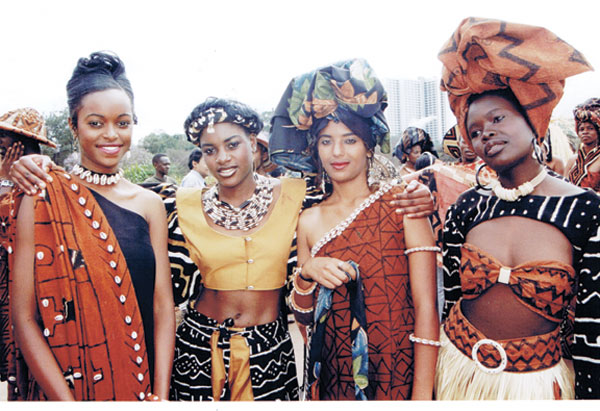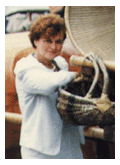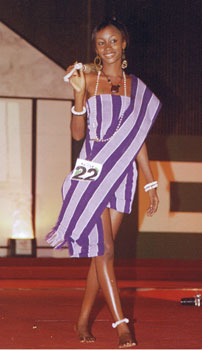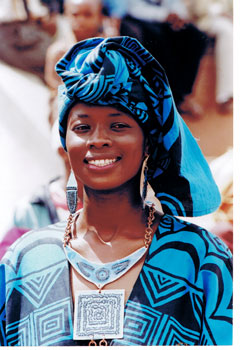|
FEATURES Ethiopia's
Omo Valley Perfectly,
Privately Pemba Journeys
in North
Africa East
Africa Hotnews Switzerland
of Africa To
Casablanca by Rail Zulu
Heritage Women
in Tourism Luxury
Vintage Rail Tour DEPARTMENTS Book
Reviews Shopping
Around Air
Highways Website |
|
by Muguette
Goufrani The wind- up gala
evenings, held twice each year, were a kaleidoscope
of color. What a splash! In this issue , we feature
something very dear to my heart, so let's start at
the top ... "le Chapeau Africain." Since hats,
bonnets, turbans, wraps and unique coiffure are
such a key part of Africa's fashion scene, I am
pleased to present my first articles on this
delightful, universal topic featuring the designs
of Alphadi, Esterella, Chrystalix, Abdela , Oumou
Sy, Gigi and others we have profiled on our ATA web
site. An expanded version will follow in Africa
Travel Magazine's 30th Jubilee editions, lighting
the spark for a Jubilee Fashion Spectacular at
Travel Shows in Africa, the USA and Canada. Visit
the Africa Travel Magazine web site for updates to
our editorial calendar, and news from the ATA
chapter level to international travel expos
attended by thousands of tourism professionals,
vacationers and travelers, who need to meet and get
to know Africans in Tourism.
Mali
Headdress Guinea
hair styles Cameroon
turban Clebrate
Africa Guinea
festive wear World's Largest
Fetish Market: While in Togo, we spent a full
day at Akodessewas, the world's largest fetish
market, with its array of sorcerers' potions;
roots, bark, monkey skulls, wart hog teeth,
porcupine skins, leopard hides, antelope horns,
bones of crocodiles, horses, pigs and monkeys, plus
various parts of human anatomy. Such concoctions
are used to cure everything from diarrhea and the
flu, to cuts, impotence and rheumatism. I tried on
a gris gris (necklace), which is said to work its
magic when blessed by a fetish priest. Part doctor,
part psychic, the priest relies on herbal
medicines, charms and a healthy dose of positive
thinking. They believe that the spirits are
everywhere -- in the air, the trees, the water -
even buildings. A priest calls on his favorite god
to predict future events, and keep evil forces at
bay. He sits on a stool in his colorful robe,
holding a regal staff, receiving gifts of gin,
which he sips as a troupe performs ritual chanting
and dancing. A sacrificial offering is made as a
show of loyalty and respect to the spirits, and to
gain special favors, such as the birth of twins.
Continued Shop
for Africa Travel Fashion! Who
would have thought when we launched Africa Travel
Magazine 14 years ago, it would become such a
popular resource for fashion. Try "Googling" for
Africa Travel Fashions or many Africa topic
sometime, and you'll notice our website at or near
the top. Ditto for Yahoo and MSN. According to
Webtrends statistics month after month, we get more
hits for fashion than any other topic - which tells
us what attracts a growing majority of our readers.
The Editor and I wear African attire almost daily
at home or away, and we pay close heed to the
simple effective ways Africans make a distinct
fashion statement. To create a lasting impression
and stand out from the humdrum, everyday world,
consider kanga and kikoi fabrics in dazzling, eye
catching colors. A
kanga is a pure cotton, with a border wide enough
to cover you comfortably. It often features a
strong, central design or theme, such as fertility
signs, mountains, landmarks, soccer stars or
popular singers. Many African ladies wear a kanga
over their skirts while working in the fi elds in
order to control the dust. A kanga is a perfect
family gift that is extremely popular throughout
Africa thanks to its other option - multiple use as
a matching or contrasting head wrap. You may see a
Swahili proverb on some kanga that is derived from
the words "guinea fowl." Why? Because the original
kanga were brightly colored Portuguese
handkerchiefs intended for gentlemen traders and
offifi cials. Theseitems were then sewn together by
Africans to create a piece large enough to be worn
head to toe - and called kangas because their
brightness reminded Africans of guinea fowl. As
village folks say, "kanga nenda na urembo, shani
urembo na shani"-"the kanga struts in style. The
kanga cloth is a lightweight loose weave fabric,
it's versatile and easy to care for. The
kikoi, woven from the fi nest cotton grown in the
region, is a rectangle of pure cotton with a work
of art inspired by the vibrant colors of East
African Coast. The traditional way of wearing kikoi
is simply wrapping it around the lower part of your
body and tucking it in at the waist. Inspired by a
multitude of colors and shapes, the kikoi are woven
in thousands of different Photos:
Top - Zanzibar girls give our ATA delegates a
rousing welcome to the Ecotourism Symposium. Above
- Esterella of Cameroon. Left ATA delegates from
USA wear colorful African garb at 31st World
Congress in Accra, Ghana. colors with hand made
tassels at the two widths and have become the must
have accessories for the beach. In Zanzibar,
designers use these two popular options in a
variety of ways. For example, in the photo at the
top of the page I took while attending an ATA
symposium, they carried the theme right through to
the sun umbrellas that complimented their attire;
What a statement they made in
their
welcoming
greeting - Jambo Zanzibar! These cloths may have
originated with what Arabs traders wore during
commerce along the East African Coast. Both
varieties make a truly treasurable gift. Cameroon's
celebrated designer Esterella makes effective use
of the kikoi and kanga in her award winning
fashions. We have had the pleasure of seeing on
display on our two recent trips to that friendly
West African country that's rich in resources and
talented entrepreneurs such as
Esterella/ What's Your
Hat-itude? I am fascinated,
and often captivated by the designs, textiles and
in particular, the head wear, hats, coiffure,
turbans and wraps of indigenous peoples around the
world. In many African societies, the choice of
colors and fabrics is outstanding and has special
significance to the wearer. Hats often tell stories
of everyday life, with its struggles, spiced by
uplifting periods of joie de vivre. While I have
worked in various African countries and journeyed
widely in my earlier career as a travel agent, my
ten year involvement with Africa Travel Magazine
has brought the importance of African fashion into
sharp focus. Speaking of focus, our library of
African fashion photos is unbelievable. It's grown
so much, we're considering an issue dedicated
solely to African fashions. How did this love
affair start? Our very first Africa Travel
Association Fashion Show was hosted by Chief
Margaret Fabiyi, who has supplied many of my
favorite wardrobe items. Her company is
Instant
Decision. Fashion will Rule! While we live in
Canada's Pacific coast, as far away from Africa as
you can get, we are always having conversations
about this wonderful continent, its people and
places, simply because our hats are recognized by
Africans who are working here or are attending
university. As a confirmed adventurer , I enjoy a
visible link to the Africans who work so hard to
create these fabrics, hats and other wardrobe
items. By supporting African designers and
artisans, our publisher, Jerry Bird and I are
contributing on behalf of the magazine, to the
economy and cultural heritage of African societies
. We are also demonstrating to all we meet in
person, on our web sites and in person, that there
is an expanding market opportunity for African
clothing and fashions. Each hat or article Jerry
and I wear promotes the country of origin. The most
noticeable items that occupy our closet to the
bursting point, are found in the collection of hats
from different African countries. We wear each one
with pride; what you might call a positive
hat-itude! Hats through the
ages Historically
Speaking |
|||||||||||||||||



 Quick
now! How well does Africa Travel Magazine's web
site score in the exciting, ever-changing world of
fashion? The answers are astounding! In a recent
search using the words Africa Fashion, our web site
ranked#1 out of 2,800,000 entries on Yahoo, and was
#1 on Google from 1,650,000 entries. Since Africa
Travel Magazine's debut in 1995, African fashion
has been a feature item on the editorial menu. It
started at an event in Benin, West Africa, with our
editor's keen observation and rapt attention to the
wide range of colorful wear of our African and
African American delegates were wearing.
Quick
now! How well does Africa Travel Magazine's web
site score in the exciting, ever-changing world of
fashion? The answers are astounding! In a recent
search using the words Africa Fashion, our web site
ranked#1 out of 2,800,000 entries on Yahoo, and was
#1 on Google from 1,650,000 entries. Since Africa
Travel Magazine's debut in 1995, African fashion
has been a feature item on the editorial menu. It
started at an event in Benin, West Africa, with our
editor's keen observation and rapt attention to the
wide range of colorful wear of our African and
African American delegates were wearing.





 Wearable
art, unique headwear and clothing styles that
reflect every corner of this vast continent of
Africa, are available in thousands of markets,
souks and boutiques across the country, including
the giant
Wearable
art, unique headwear and clothing styles that
reflect every corner of this vast continent of
Africa, are available in thousands of markets,
souks and boutiques across the country, including
the giant  What
is Kente Cloth? Basically,
it's an Asante ceremonial cloth that is hand-woven
on a horizontal treadle loom. The looms we saw at
the village near Kumasi were out in the open air,
although in a grassy, shaded area. Cloth strips,
approximately 4 inches wide are sewn together into
larger bolts. Of many colors, sizes and designs,
Kente cloth items, long scarfs in particular, are
worn throughout Ghana and its neighboring
countries, during most social and religious
occasions. The name comes from the word 'kenten',
which means basket. We saw virtually every possible
color and pattern of kente cloth during the
day-long Durbar ceremony at Koforidua village near
Accra. According to Ghanaians, kente depicts the
area's history and philosophy, its ethics, oral
literature, moral values, social and religious
concepts
What
is Kente Cloth? Basically,
it's an Asante ceremonial cloth that is hand-woven
on a horizontal treadle loom. The looms we saw at
the village near Kumasi were out in the open air,
although in a grassy, shaded area. Cloth strips,
approximately 4 inches wide are sewn together into
larger bolts. Of many colors, sizes and designs,
Kente cloth items, long scarfs in particular, are
worn throughout Ghana and its neighboring
countries, during most social and religious
occasions. The name comes from the word 'kenten',
which means basket. We saw virtually every possible
color and pattern of kente cloth during the
day-long Durbar ceremony at Koforidua village near
Accra. According to Ghanaians, kente depicts the
area's history and philosophy, its ethics, oral
literature, moral values, social and religious
concepts Kanga
Who?
Kanga
Who? What's
a Kikoi?
What's
a Kikoi? based
in Lagos, Nigeria.
based
in Lagos, Nigeria.